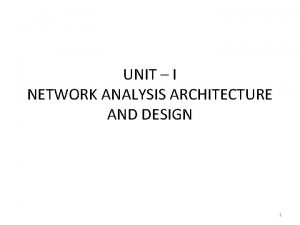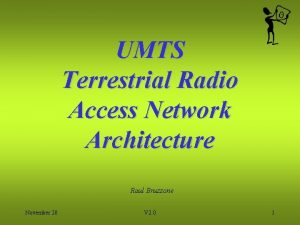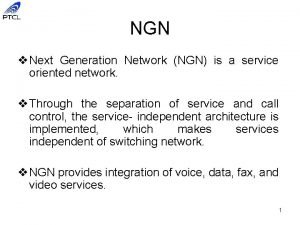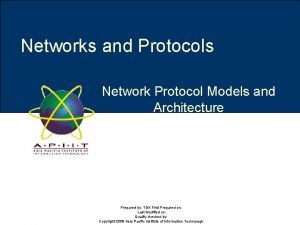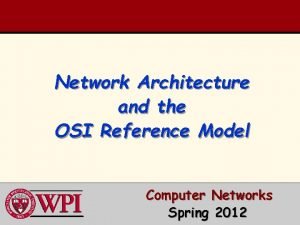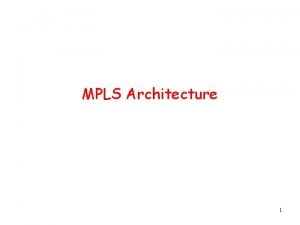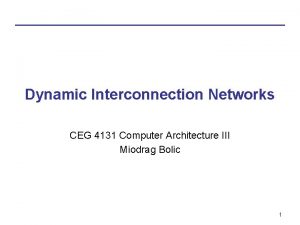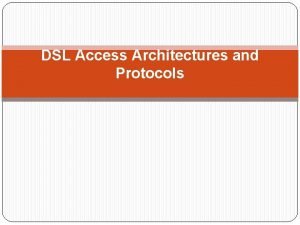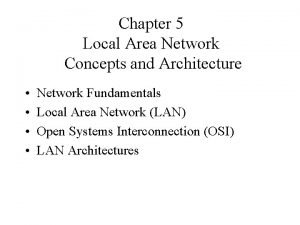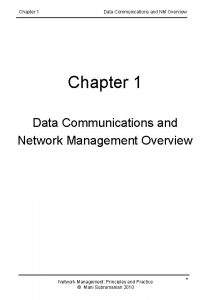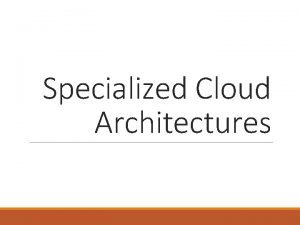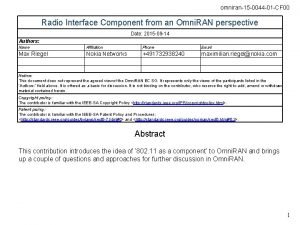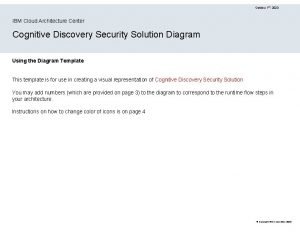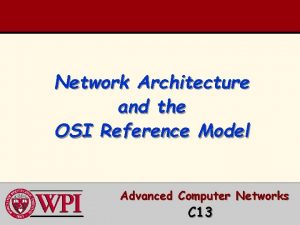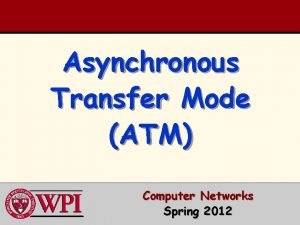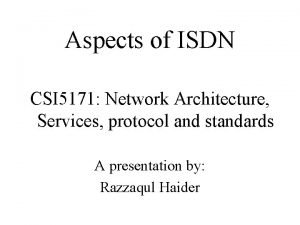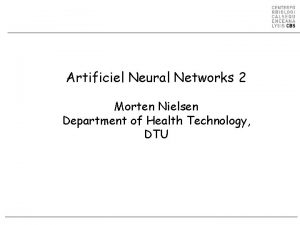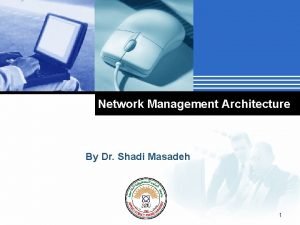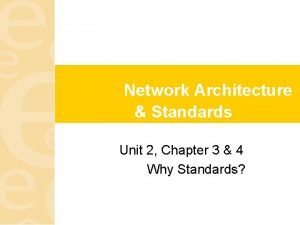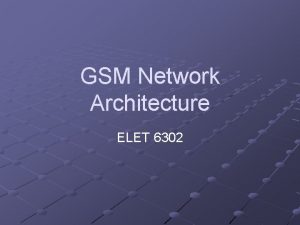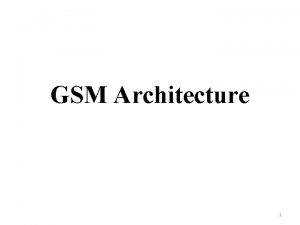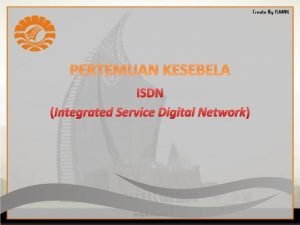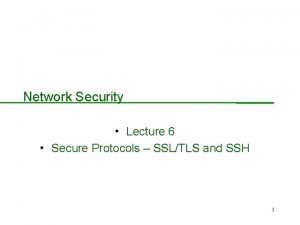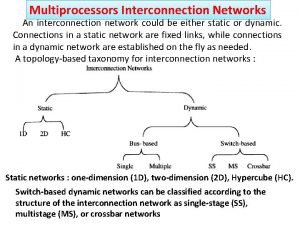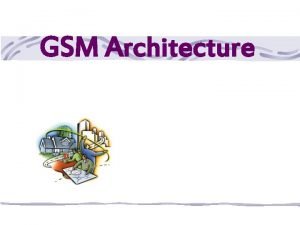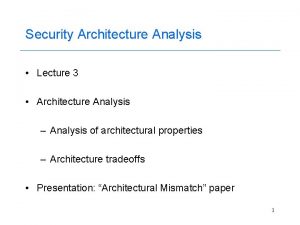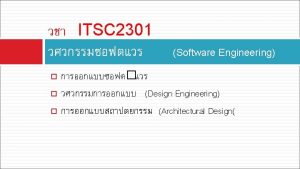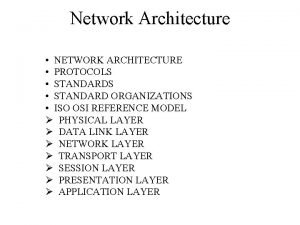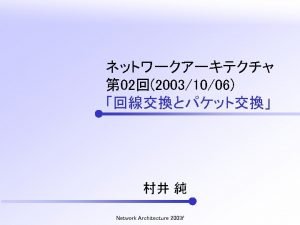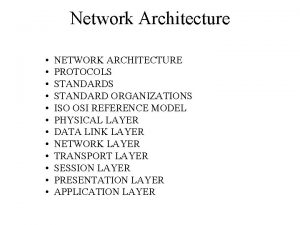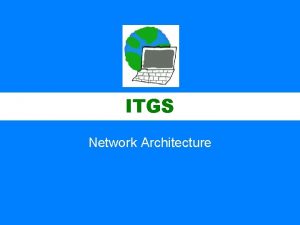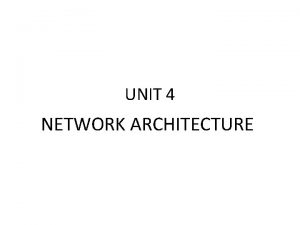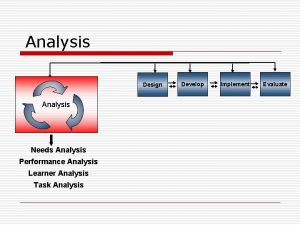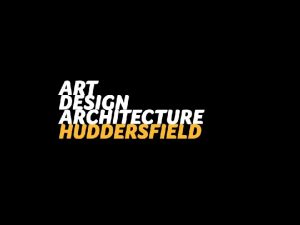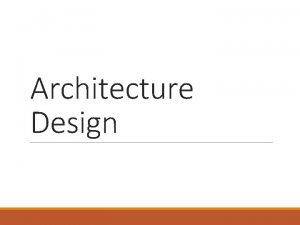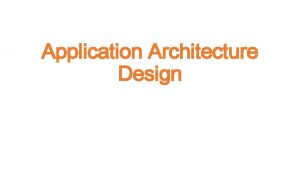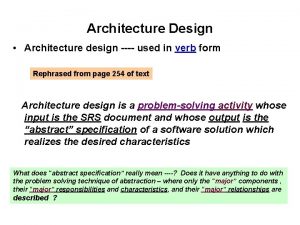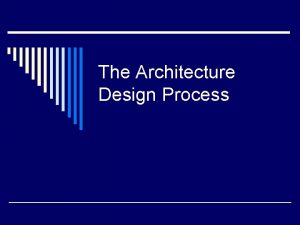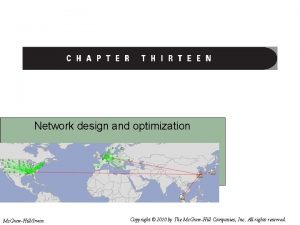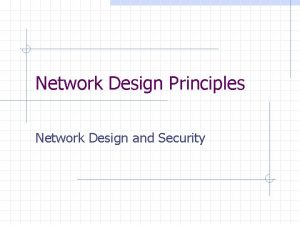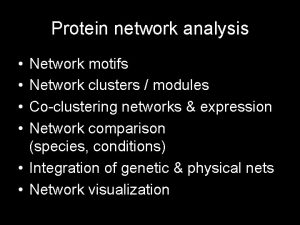UNIT I NETWORK ANALYSIS ARCHITECTURE AND DESIGN 1
























































- Slides: 56

UNIT – I NETWORK ANALYSIS ARCHITECTURE AND DESIGN 1

Network Design • Through the Kurose text we’ve covered – The application, transport, network, & link layers – Wireless and multimedia technologies – Security – Network management • Not bad! • So how does all this come together to help create a network? INFO 331 Network Design 2

Network Design • Ok, that’s not a small question – we’ll just tickle the surface (not even scratch!) • Main resources for this section are: – Mc. Cabe, James D. (2003). Network Analysis, Architecture & Design (2 nd Ed. ). San Francisco: Morgan Kaufmann Publishers. [Chapters 1 -5, 10] – Teare, Diane. (2004). CCDA Self-Study: Designing for Cisco Internetworking Solutions (DESGN). Indianapolis: Cisco Press. INFO 331 Network Design 3

Network Design Objective • Ultimately, our network design must answer some pretty basic questions – What stuff do we get for the network? – How do we connect it all? – How do we have to configure it to work right? • Traditionally this meant mostly capacity planning – having enough bandwidth to keep data moving – May be effective, but result in over engineering INFO 331 Network Design 4

Network Design Objective • And while some uses of the network will need a lot of bandwidth (multimedia), we may also need to address: – Security • Considering both internal and external threats – Possible wireless connectivity – Reliability and/or availability • Like speed for a car, how much are you willing to afford? INFO 331 Network Design 5

Network Design Phases • Designing a network is typically broken into three sections: – Determine requirements – Define the overall architecture – Choose technology and specific devices (Mc. Cabe, 2003) INFO 331 Network Design 6

Systems Methodology • There’s lots of room for refining these sections (Teare, 2004) – Identify customer requirements – Characterize the existing network – Design topology – Plan the implementation – Build a pilot network – Document the design – Implement the design, and monitor its use INFO 331 Network Design 7

Two Main Principles • For a network design to work well, we need to balance between – Hierarchy – how much network traffic flows connect in tiers of organization • Like tiers on an org chart, hierarchy provides separation and structure for the network – Interconnectivity – offsets hierarchy by allowing connections between levels of the design, often to improve performance between them INFO 331 Network Design 8

Two Main Principles (Mc. Cabe, 2003) INFO 331 Network Design 9

SERVICE REQUESTS AND REQUIREMENTS • They are identified by the degree of predictability needed from the service by the users, applications or devices Best of effort Predictable Guarenteed 10

Best Of Effort Service • No control over how the network will satisfy the service requests • Indicates that the rest of the system will have to adapt to the state of the network at any given time • Services will be both un-predictable and unreliable • Variable performance across a range of values • No specific performance requirements INFO 331 Network Design 11

GUARANTEED SERVICE • These services are predictable and reliable • They imply a contract between the user and the provider • When the contract is broken the provider is accountable and must account for loss of service and compensate the user. INFO 331 Network Design 12

Predictable services • These services fall in between best of effort and guaranteed services • They offer some degree of predictability and yet are not accountable. • Predictable and guaranteed are based on some prior knowledge of and control over the state of the system • These services must have clear set of service requirements • These requirements must be configurable , measurable and verifiable • Ex: a bandwidth of 4 -10 mbps. We should be able to communicate this request, measure / derive the level of resources needed and then determine whether the resources are actually available INFO 331 Network Design 13

Ex: performance of a 100 mbps FE connection. INFO 331 Network Design 14

SERVICE METRICS • (i) Threshold values: is a value for a performance characteristic that is a boundary between two regions of conformance • (ii) limit: is a boundary between conforming and non conforming regions and is taken as an upper or lower limit for a performance characteristic. • Limits are more dangerous than thresholds and result in severe actions INFO 331 Network Design 15

Requirements • Service requirements could include the Qo. S (quality of service) guarantees (ATM, Intserv, Diffserv, etc. ) – This connects to network management monitoring of network performance 16

Performance Characteristics Capacity INFO 331 Delay Network Design RMA 17

Capacity • Is a measure of the systems ability to transfer information • Bandwidth, throughput and goodput are the terms associated with it. INFO 331 Network Design 18

DELAY • Is the time difference in the transmission of information across the system. • Sources of delay (i) propagation delay (ii) transmission delay (iii) queuing and processing delay • Measures of delay( i) end-end delay (ii) RTT (iii) latency (iv) Delay Variation INFO 331 Network Design 19

RMA Reliability • Is a statistical indicator of the frequency of failures of the network and its components • Reliability also requires some degree of predictability. The delivery of information must occur within well known time boundaries. • When delivery time varies greatly , the confidence in the network is lost and hence is considered less reliable INFO 331 Network Design 20

Maintainability • Is a statistical measure of the time to restore the system to fully operational mode after it has experienced a fault • Generally expressed as (i) MTTR (mean time to repair) : total time taken for detection, isolation of the failure to a component that can be replcaed, Delivery of necessary partsnto the location of the failed component (logistic time), replca the component, test it and restore full service INFO 331 Network Design 21

Availability • Is a relationship between the frequency of mission critical failures and the time to restore service • A= MTBF/ (MTBF +MTTR) • MTBF = mean time between failures • MTTR = mean time to repair • A= availability INFO 331 Network Design 22

Performance envelope • Is a combination of two or more performance requirements, with thresholds and upper and lower limits for each INFO 331 Network Design 23

Network supportability • The 80/20 rule applies here – 80% of the cost of a network is its operation and support – Only 20% is the cost of designing and implementing it • So plan for easy operation, maintenance, and upgrade of the network INFO 331 Network Design 24

Post Implementation of the network life cycle • Phase 1: operation: The network and the systems are properly operated and managed and required maintenance are identified • Phase 2 : Maintenance: Preventive and corrective maintenance and the parts, tools plans and procedures for accomplishing this task • Phase 3: Human knowledge : Documentation, training and skilled person required to operate and maintain the system INFO 331 Network Design 25

Key characteristics that Affect post implementation cost • Network and system Reliability • Network and system Maintainability • Training of the operators to stay within operational constraints • Quality of the staff required for maintenance actions INFO 331 Network Design 26

Requirements? Booooring! • Yes, determining the requirements for a network probably isn’t as much fun as shopping for really expensive hardware – And that may be why many networks are poorly designed – no one bothered to think through their requirements! – Many people will jump to a specific technology or hardware solution, without fully considering other options – the obvious solution may not be the best one INFO 331 Network Design 27

Requirements • We need to develop the low level design and the higher level architecture, and understand the environment in which they operate • We also need to prove that the design we’ve chosen is ‘just right’ (Southey, 1837) – Is that $2 million network backbone really enough to meet our needs? – How do we know $500, 000 wouldn’t have been good enough? INFO 331 Network Design 28

Requirements • Part of this process is managing the customer’s expectations – They may expect a much simpler or more expensive solution than is really needed – Showing analysis of different design options, technologies, or architectures can help prove you have the best solution INFO 331 Network Design 29

Requirements • We need to use a systems approach for understanding the network – The system goes far beyond the network hardware, software, etc. – Also includes understanding the users, applications or services, and external environment • How do these need to interact? • What does the rest of the organization expect from the network? INFO 331 Network Design 30

Requirements • Consider how devices communicate Images from (Mc. Cabe, 2003) unless noted otherwise INFO 331 Network Design 31

Requirements • What services are expected from the network? – Typical performance levels might include capacity, delay time, reliability • Providing 1. 5 Mb/s peak capacity to a remote user • Guaranteeing a maximum round-trip delay of 100 ms to servers in a server farm – Functions include security, accounting, scheduling, management • Defining a security or privacy level for a group of users or an organization INFO 331 Network Design 32

Requirements • Capacity refers to the ability to transfer data – Bandwidth is theoretical capacity of some part of the network – Throughput is the actual capacity, which is less than the bandwidth, due to protocol overhead, network delays, etc. • Kind of like hard drive actual capacity is always less than advertised, due to formatting INFO 331 Network Design 33

Requirements Analysis • Given these concepts, how do we describe requirements for a network? • Need a process to filter or classify requirements – Network requirements (often have high, medium, low priorities) – Future requirements (planned upgrades) – Rejected requirements (remember for future ref. ) – Informational requirements (ideas, not required) INFO 331 Network Design 34

Requirements Analysis • Requirements can come from many aspects of the network system – User Requirements – Application Requirements – Device Requirements – Network Requirements – Other Requirements INFO 331 Network Design 35

User Requirements • User requirements are often qualitative and very high level – What is ‘fast enough’ for download? System response (RTT)? – How good does video need to be? – What’s my budget? INFO 331 Network Design 36

Application Requirements • What types of apps are we using? – Mission-critical – Rate-critical – Real-time and/or interactive • How sensitive are apps to RMA (reliability, maintainability, availability)? • What capacity is needed? • What delay time is acceptable? INFO 331 Network Design 37

Application Requirements • What groups of apps are being used? – Telemetry/command control - remote devices – Visualization and simulation – Distributed computing – Web development, access, and use – Bulk data transport – FTP – Teleservice – VOIP, teleconference – Operations, admin, maintenance, and provisioning (OAM&P) – DNS, SMTP, SNMP – Client-server – ERP, SCM, CRM INFO 331 Network Design 38

Application Requirements • Where are the apps located? • Are some only used in certain locations? INFO 331 Network Design 39

Device Requirements • What kinds of devices are on your network? – Generic computing devices include normal PCs, Macs, laptops, handheld computers, workstations – Servers include all flavors of server – file, print, app/computation, and backup – Specialized devices include extreme servers (supercomputers, massively parallel servers), data collection systems (POS terminals), industryspecific devices, networked devices (cameras, tools), stoplights, ATMs, etc. INFO 331 Network Design 40

Device Requirements • Specialized devices are often locationspecific INFO 331 Network Design 41

Device Requirements • We want an understanding of the device’s performance – its ability to process data from the network – Device I/O rates – Delay time for performing a given app function INFO 331 Network Design 42

Device Requirements • Performance results from many factors – Storage performance, that is, flash, disk drive, or tape performance – Processor (CPU) performance – Memory performance (access times) – Bus performance (bus capacity and arbitration efficiency) – OS performance (effectiveness of the protocol stack and APIs) – Device driver performance INFO 331 Network Design 43

Device Requirements • The device locations are also critical – Often generic devices can be grouped by their quantity – Servers and specialized stuff are shown individually INFO 331 Network Design 44

Network Requirements • Network requirements (sounds kinda redundant) are the requirements for interacting with the existing network(s) and network management concerns • Most networks have to integrate into an existing network, and plan for the future evolution of the network INFO 331 Network Design 45

Network Requirements • Issues with network integration include – Scaling dependencies – how will the size of the existing network affect the new one? • Will the existing network change structure, or just add on a new wing? – Location dependencies – interaction between old and new networks could change the location of key components – Performance constraints – existing network could limit performance of the new one INFO 331 Network Design 46

Network Requirements – Network, system, and support service dependencies • Addressing, security, routing protocols and network management can all be affected by the existing network – Interoperability dependencies • Changes in technology or media at the interfaces between networks need to be accounted for, as well as Qo. S guarantees, if any – Network obsolescence – do protocols or technologies become obsolete during transition? INFO 331 Network Design 47

Network Requirements • Network management and security issues need to be addressed throughout development – How will the network be monitored for events? – Monitoring for network performance? • What is the hierarchy for management data flow? – Network configuration? – Troubleshoot support? INFO 331 Network Design 48

Network Requirements • Security analysis can include the severity (effect) of an attack, and its probability of occurrence Effect/ Probability User Devices Servers Network Software Services Data Unauthorized Access B/A B/B C/B A/B B/C A/B Unauthorized Disclosure B/C B/B C/C A/B B/C A/B Denial of Service B/B B/B B/B D/D Theft A/D B/D A/B C/C A/B Corruption A/C B/C C/C A/B D/D A/B Viruses B/B B/B B/C D/D Physical Damage A/D B/C C/C D/D D/D Effect: INFO 331 Probability: A: Destructive C: Disruptive A: Certain C: Likely B: Disabling D: No Impact B: Unlikely D: Impossible Network Design 49

Other Requirements • Requirements can come from other outside sources – your customer, legal requirements, larger scale organization (enterprise) requirements, etc. • Additional requirements can include – Operational suitability – how well can the customer configure and monitor the system? – Supportability – how well can the customer maintain the system? INFO 331 Network Design 50

Other Requirements – Confidence – what is the data loss rate when the system is running at its required throughput? • Financial requirements can include not only the initial system cost, but also ongoing maintenance costs – System architecture may be altered to remain within cost constraints • This is a good reason to present the customer with design choices, so they see the impact of cost versus performance INFO 331 Network Design 51

Other Requirements • Enterprise requirements typically include integration of your network with existing standards for voice, data, or other protocols INFO 331 Network Design 52

Requirements Spec and Map • A requirements specification is a document which summarizes the requirements for (here) a network – Often it becomes a contractual obligation, so assumptions, estimates, etc. should be carefully spelled out • Requirements are classified by Status, as noted earlier (core/current, future, rejected, or informational requirement) INFO 331 Network Design 53

Requirements of an Company • • • 1 building must. 150 users (60 engineers, 15 HR, and finance, 30 manufacturing 10 management, 30 sales/marketing, 5 others) Each area in building the support fast ethernet connection to the backbone Database , visualisation Manufacturing, and payroll applications are considered mission critical Inventory applications are not determined at this time Database applications require a min. of 150 kbps Engineering users have a workstation with giga. E NICs Visualisation applications for finance require 40 Mbps capacity and 100 ms round trip delay Payroll apps require 100% up time Company must be secure from internet attack Company requires a min. of T! access to internet INFO 331 Network Design 54

Requirements Spec and Map l l l Priority can provide additional numeric distinction within a given Status (typically on a 1 -3 or 1 -5 scale) Sources for Gathering requirements can be identified, or give basis for Deriving it Type is user, app, device, network or other Requirements Specification ID/Name INFO 331 Date Type Description Gathered/Derived Network Design Locations Status Priority 55

Requirements Spec and Map • Requirements Mapping can show graphically where stuff is, what kind of apps are used, and existing connectivity INFO 331 Network Design 56
 Network analysis architecture and design
Network analysis architecture and design Ece 526
Ece 526 Aadl tutorial
Aadl tutorial What is input output design
What is input output design Spatial design network analysis
Spatial design network analysis User interface design in system analysis and design
User interface design in system analysis and design Dialogue design
Dialogue design Unit 6 review questions
Unit 6 review questions Advantages of structured analysis
Advantages of structured analysis Fact finding techniques in sad
Fact finding techniques in sad Technical feasibility example
Technical feasibility example Data centered architecture
Data centered architecture Diff between virtual circuit and datagram network
Diff between virtual circuit and datagram network Features of peer to peer network and client server network
Features of peer to peer network and client server network Network centric computing and network centric content
Network centric computing and network centric content What is architecture business cycle?
What is architecture business cycle? Modular product architectures
Modular product architectures Fundamental and incidental interactions
Fundamental and incidental interactions Buses in computer architecture
Buses in computer architecture Wcdma network architecture
Wcdma network architecture What is the osi security architecture
What is the osi security architecture Chordal ring
Chordal ring Ngn network architecture
Ngn network architecture Network file system architecture
Network file system architecture Network protocol architecture
Network protocol architecture Osi architecture
Osi architecture Mpls network architecture
Mpls network architecture Telecommunications network architecture
Telecommunications network architecture Gsm network infrastructure
Gsm network infrastructure Clos data center network architecture
Clos data center network architecture Dynamic interconnection network in computer architecture
Dynamic interconnection network in computer architecture Dsl network architecture
Dsl network architecture Network protocol architecture
Network protocol architecture Local area network architecture
Local area network architecture Network management dumbbell architecture
Network management dumbbell architecture Dumbbell architecture in network management
Dumbbell architecture in network management Broadband network gateway architecture
Broadband network gateway architecture Persistent virtual network configuration architecture
Persistent virtual network configuration architecture Access network architecture
Access network architecture Cognos 11 architecture diagram
Cognos 11 architecture diagram Osi network architecture
Osi network architecture 2 network models
2 network models Enterprise network architecture
Enterprise network architecture Atm in computer networks
Atm in computer networks Architecture of isdn
Architecture of isdn Slideshare
Slideshare Out of band management architecture
Out of band management architecture Network architecture standards
Network architecture standards Gsm network architecture
Gsm network architecture Gsm switching system
Gsm switching system Traditional network vs sdn
Traditional network vs sdn Yang bukan merupakan tujuan isdn ialah
Yang bukan merupakan tujuan isdn ialah Prp network architecture
Prp network architecture Ssl architecture in network security
Ssl architecture in network security Osi network architecture
Osi network architecture Dynamic interconnection network in computer architecture
Dynamic interconnection network in computer architecture Gsm auc
Gsm auc
